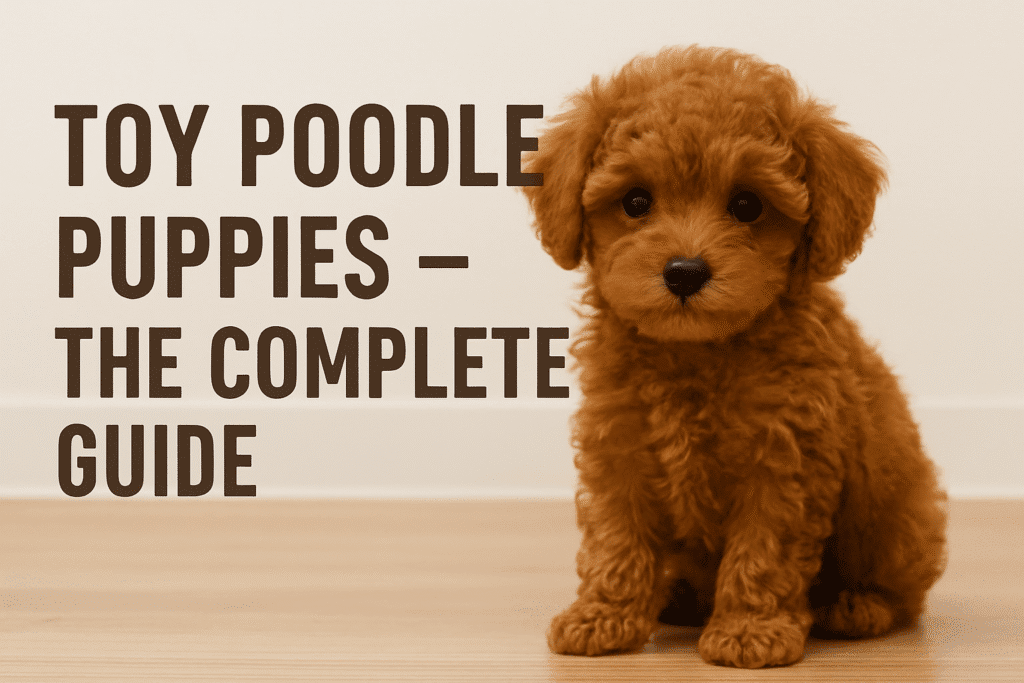introduction to Toy Poodle Puppies
If you’ve ever wanted a pet that’s equal parts elegance, brains, and mischief, the toy poodle puppy might just be your dream come true. Small but mighty, these curly-coated charmers win people over not just with looks, but with a personality that lights up a room.
Why Toy Poodles Are So Popular
It’s no surprise they’re one of the most adored small breeds worldwide. They’re clever—ridiculously clever—and quick to pick up commands. Add their manageable size and hypoallergenic coats into the mix, and you’ve got the ultimate city-friendly companion.
A Glimpse Into Their History
Though many think of France when they hear “poodle,” their story actually traces back to Germany, where they were water retrievers. Over time, selective breeding produced the toy version—bred for companionship rather than work. Before long, European royals had them prancing around palaces.
Understanding the Toy Poodle Breed
Breed Standards and Size
These dogs are tiny, usually weighing between 4–6 pounds and standing just under 10 inches tall. Don’t be fooled by their size though; they carry themselves with the confidence of a much larger dog.
Toy vs Miniature vs Standard Poodles
Think of it as a family with three siblings. The standard is the big one, the miniature is the middle child, and the toy is the smallest—yet all share that iconic poodle style and smarts.
Personality Traits You’ll Notice
Affectionate? Absolutely. Loyal? Without question. Stubborn? Sometimes. They’re alert, playful, and thrive when included in daily life.
Appearance and Physical Features
Coat Texture and Color Variety
The toy poodle’s curly coat feels like soft wool. Their coats come in a rainbow of shades: jet black, snowy white, rich red, warm apricot, sleek silver, and even more.
Grooming Demands
Unlike shedding breeds, their coats grow continuously, almost like human hair. Regular trims are a must unless you want them looking like a walking mop.
Distinctive Characteristics
Expressive eyes, floppy ears, and a proud gait make them instantly recognizable.
Temperament and Behavior
Their Social Side
These little dogs crave attention and bond closely with their humans. Leave them alone too often, and they may get anxious.
Brains and Trainability
Toy poodles are problem solvers. They love mental challenges, which makes training both fun and rewarding.
How They Fit Into Family Life
With older kids, they’re wonderful playmates. With toddlers, supervision is best—they’re tiny and can get injured easily.
Health and Lifespan
Common Health Concerns
Like all breeds, they have their weak spots: knee issues (patellar luxation), dental problems, and eye disorders.
Average Life Expectancy
12–15 years is the norm, but many live well beyond that with attentive care.
Keeping Them Healthy Long-Term
Regular vet check-ups, balanced meals, and exercise will help your toy poodle thrive for years.
Feeding Your Toy Poodle Puppy
Nutritional Needs at Different Stages
Protein is their fuel, fats keep their coats glossy, and vitamins support growing bones.
Feeding Schedules by Age
- 8–12 weeks → 4 meals daily
- 3–6 months → 3 meals daily
- 6 months+ → 2 meals daily
Foods That Should Never Be Given
Keep chocolate, grapes, onions, garlic, and fatty scraps far away from their tiny stomachs.
Training and Socialization
House Training Essentials
Consistency is everything. Crate training not only helps with potty training but also gives them a safe retreat.
Must-Know Commands
Start small—sit, stay, come. With patience, you’ll be amazed how quickly they master it.
Early Socialization Practices
Introduce them early to new faces, pets, and environments to avoid shyness or fear later in life.
Exercise and Activity Needs
Daily Energy Burn
Despite being pint-sized, they’re full of pep. Thirty minutes of exercise a day keeps them content.
Games They Adore
Fetch, agility runs, and hide-and-seek make their eyes sparkle.
Mental Stimulation
Boredom is their enemy. Puzzle toys and trick training keep their sharp minds busy.
Grooming and Maintenance
Bathing and Brushing Basics
Daily brushing prevents tangles. A bath every three to four weeks keeps them looking their best.
Popular Haircut Styles
From the classic poodle trim to the modern teddy bear look, grooming allows for plenty of creativity.
Nail, Ear, and Dental Care
Regular nail trims, weekly ear cleaning, and daily tooth brushing are must-dos.
Cost of Owning a Toy Poodle Puppy
Initial Investment
Depending on lineage, prices range from $1,000–$3,000.
Monthly and Yearly Expenses
Food, grooming, vet bills, and supplies average $100–$200 monthly.
Hidden Costs Owners Forget
Emergency vet visits or long-term medical care can add up quickly. Pet insurance is worth considering.
Choosing a Toy Poodle Puppy
Spotting Ethical Breeders
A good breeder provides health records, welcomes questions, and genuinely cares about the puppies’ welfare.
Buying vs Adopting
Adoption saves lives. Many poodles end up in rescues waiting for a second chance.
Red Flags That Signal Trouble
Avoid breeders who dodge health questions or keep puppies in poor conditions.
Preparing Your Home for a Puppy
Puppy-Proofing the House
Hide wires, secure trash cans, and remove choking hazards.
Must-Have Supplies
Food bowls, quality kibble, a comfy bed, chew toys, a leash, and grooming tools.
What to Expect on Day One
The first day may be overwhelming for them. Keep the routine simple, calm, and full of reassurance.
Living with a Toy Poodle
A Day in Their Life
Morning walks, playtime, naps, training, and cuddles—it’s a mix of activity and affection.
Traveling Together
Their small size makes them excellent travel buddies. Just make sure you’ve got a safe carrier.
Creating a Strong Bond
Consistency, patience, and quality time forge an unbreakable connection.
Toy Poodle Myths and Facts
Are They Truly Hypoallergenic?
Yes, many allergy sufferers tolerate them better because of their low-shedding coats.
Fragile or Surprisingly Sturdy?
They may look delicate, but they’re tougher than you think when handled properly.
Do They Really Bark That Much?
They can be vocal, but with training, barking can be kept under control.
Conclusion
Tiny in size, massive in personality—that’s the toy poodle in a nutshell. They’re affectionate, whip-smart, and adaptable. Whether you live in a city apartment or a country cottage, with the right love and care, a toy poodle puppy will be the loyal companion you didn’t know you needed.
FAQs
1. How big do Toy Poodle puppies get?
They reach about 9–10 inches in height and weigh between 4–6 pounds.
2. Are Toy Poodles beginner-friendly dogs?
Yes, their intelligence and affectionate nature make them an excellent choice for first-time dog owners.
3. How often do Toy Poodles need grooming?
Plan for professional grooming every 4–6 weeks, plus regular brushing at home.
4. Do they suffer from separation anxiety?
They can—these pups form strong bonds and dislike being left alone for too long.
5. What diet suits a Toy Poodle puppy best?
High-quality, small-breed puppy food with plenty of protein and essential nutrients



